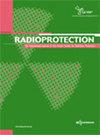Assessment of entrance skin dose for adult patients undergoing diagnostic X-ray Examinations in the Souss Massa Region of Morocco
IF 1.8
4区 医学
Q4 ENVIRONMENTAL SCIENCES
引用次数: 1
Abstract
The objective of this study is to evaluate entrance skin doses, and to establish the diagnostic reference levels for the most common x-ray examinations in adult patients in the Souss Massa region of Morocco. Data from 720 adult patients in four radiology departments in the Souss Massa region were collected. The data concerned the following examinations: Thorax posterior anterior (PA), unprepared abdominal x-ray, pelvis, hip, cervical spine anterior-posterior (AP) and lateral (Lat), lumbar spine anterior-posterior (AP) and lateral (Lat). The following parameters were reported for each examination: Age, weight, patient thickness, voltage (kV), electrical charge (mAs), and the skin source distance. The Entrance Skin Dose (ESD) and the Diagnostic Reference Levels (DRL) are calculated for each X-ray examination. DRLs in terms of ESD for the same x-ray examination differ widely from one hospital to another. They ranged from 3 to 14 mGy for the unprepared abdominal x-ray, from 2.6 to 9.4 mGy for the pelvis, from 3.1 to 17 mGy for the hip, from 1 to 49.2 mGy for the cervical spine Lat, from 2 to 32.6 mGy for the lumbar spine AP, and from 18.1 to 50 mGy for the lumbar spine Lat. The variation of doses received by patients in the four hospitals calls into question radiological procedures and practices and calls for a standardization of guidelines for each radiological examination.评估摩洛哥苏马萨地区接受诊断性x射线检查的成年患者的入口皮肤剂量
本研究的目的是评估入口皮肤剂量,并为摩洛哥Souss Massa地区成年患者最常见的x射线检查建立诊断参考水平。收集了苏马萨地区四个放射科720名成年患者的数据。数据涉及以下检查:胸后前位(PA),未准备腹部x线片,骨盆,髋关节,颈椎前后位(AP)和侧位(Lat),腰椎前后位(AP)和侧位(Lat)。每次检查报告以下参数:年龄、体重、患者厚度、电压(kV)、电荷(mAs)和皮肤源距离。每次x光检查均计算皮肤入口剂量(ESD)和诊断参考水平(DRL)。在同一x线检查中,不同医院在ESD方面的drl差异很大。未准备腹部x线检查为3至14 mGy,骨盆为2.6至9.4 mGy,髋关节为3.1至17 mGy,颈椎Lat检查为1至49.2 mGy,腰椎AP检查为2至32.6 mGy,腰椎Lat检查为18.1至50 mGy。这四家医院的病人所接受剂量的变化使人们对放射治疗程序和做法提出质疑,并要求对每次放射检查的指导方针进行标准化。
本文章由计算机程序翻译,如有差异,请以英文原文为准。
求助全文
约1分钟内获得全文
求助全文
来源期刊

Radioprotection
ENVIRONMENTAL SCIENCES-PUBLIC, ENVIRONMENTAL & OCCUPATIONAL HEALTH
CiteScore
3.30
自引率
54.50%
发文量
35
审稿时长
>12 weeks
期刊介绍:
Radioprotection publishes articles on all aspects of radiological protection, including non-ionising as well as ionising radiations. Fields of interest range from research, development and theory to operational matters, education and training. The very wide spectrum of its topics includes (theoretical and practical aspects): dosimetry, instrument development, specialized measuring techniques, epidemiology, biological effects (in vivo and in vitro) and risk and environmental impact assessments.
 求助内容:
求助内容: 应助结果提醒方式:
应助结果提醒方式:


